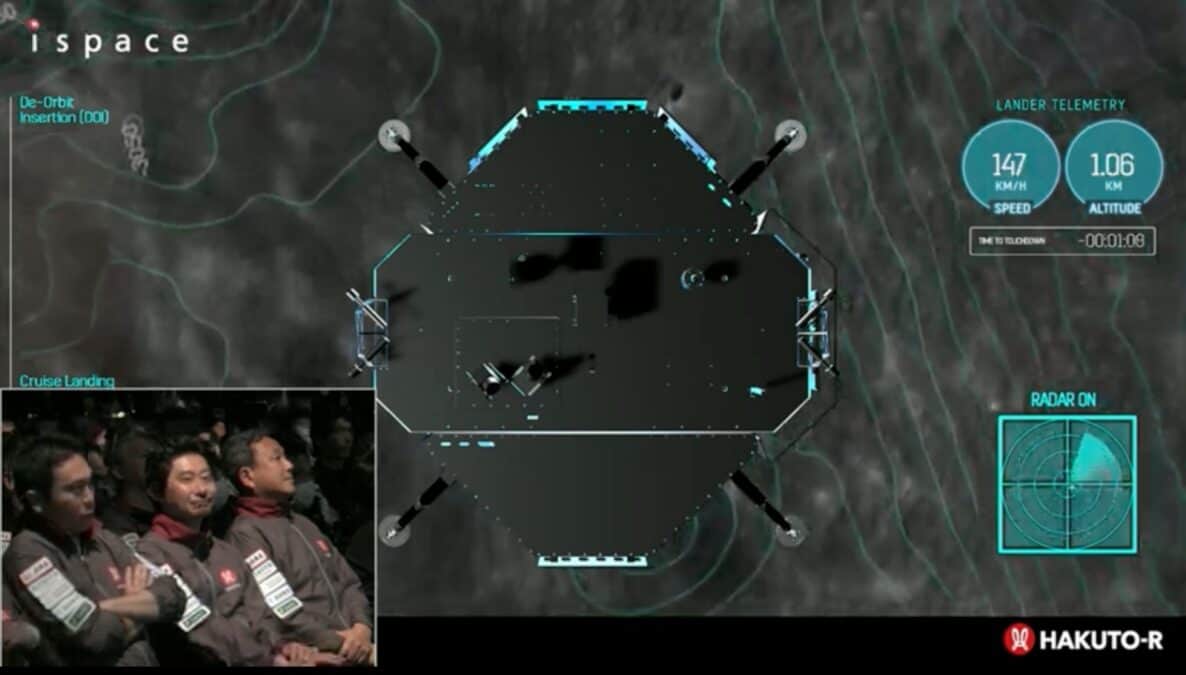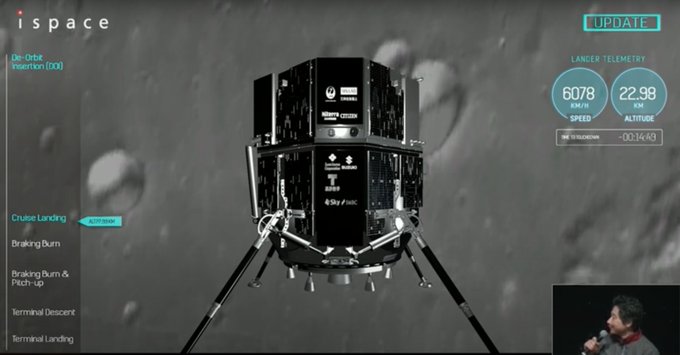Dubai, UAE – Despite the unfortunate outcome of the HAKUTO-R Mission 1, which did not manage to land safely on the lunar surface, the Mohammed Bin Rashid Space Centre (MBRSC) praised the tremendous efforts made by mission partner ispace.
“The Rashid Rover and other payloads onboard the lander were unable to continue their respective missions,” it said in a statement.
Nevertheless, the MBRSC remains proud of their accomplishments, including the development of the Rashid Rover and becoming the first Emirati and Arab lunar mission to successfully enter the Moon’s orbit, the Center added.
The MBRSC expressed gratitude to the French space agency, CNES, for their valuable scientific and technical contributions throughout the mission.
Also Read Tokyo firm loses contact with lander carrying UAE’s moon explorer
The MBRSC also acknowledged the support of local and international partners, as well as the invaluable insights gained in the process. Despite the setback, the team at MBRSC remains inspired and believes that greater accomplishments are yet to come in their pursuit of space exploration.
The UAE-made Rashid Rover aboard the Hakuto Mission 1 Lunar lander was nearing its destination on the Moon when the team on the ground lost contact with the spacecraft.
The outcome of the Rashid rover landing marks only the beginning of a promising journey of exploration. Our colleagues have developed the first Emirati and Arab Rover; a notable achievement in and of itself and one we can all stand proudly behind.
Salem AlMarri, Director General of Mohammed Bin Rashid Space Centre
Thank you to the entire team for their unwavering devotion and hard work. We also thank our mission partners, ispace and CNES for their commendable efforts and their spirit of collaboration.
Our leaders have taught us to achieve our goals through bold ambition and dedication. They encourage us to make the impossible possible. Challenges and difficulties are an inherent part of space missions, and particularly for lunar landings. By embarking on difficult missions, we learn, we improve and we progress.
The lunar lander was expected to touch down at 8:40 PM UAE time, but according to ispace, the Japan-based company that operated the mission, they were unable to verify the lander’s success.
The communication blackout occurred during the final 33 feet (10 meters) of descent, with the lander travelling at around 16 mph (25 kph).
#JUSTIN @iSpace reports that contact with the Hakuto R lander has been lost, as it was unable to confirm the landing vehicle. The iSpace team continues to study the situation, and will provide an update when this is over.#EmiratesLunarMission #UAEtotheMoon @ispace_inc… pic.twitter.com/xszNIgq2o6
— TRENDS (@mena_trends) April 25, 2023
ispace had tweeted last night that they “have lost communication” with the HAKUTO-R lander and “have not been able to confirm a successful landing”.
The UAE-built rover was expected to explore the characteristics of lunar soil, the petrography and geology of the Moon, dust movement, surface plasma conditions and the Moon’s photoelectron sheath.
The UAE would have become the first Arab country and only the fourth country in the world to land on the Moon — after the United States, the former Soviet Union, and China.
The UAE announced in September 2020 that it planned to launch the “Rashid” rover by 2024. The Emirates is a newcomer to the world of space exploration but is quickly making its mark.
In September 2019, the country sent the first Emirati into space as part of a three-member crew that blasted off on a Soyuz rocket from Kazakhstan for an eight-day mission.
Then in February, its “Hope” probe successfully entered Mars’ orbit on a journey to reveal the secrets of Martian weather, making history as the Arab world’s first interplanetary mission.
Rashid Rover completed nearly four-and-a-half months in space, travelling more than 1.34 million km, according to MBRSC. It had lifted off on 11 Dec 2022 from Cape Canaveral Space Force Station in Florida.
New missions
Japanese start-up ispace, meanwhile, conceded Wednesday its ambitious attempt to become the first company to land on the Moon had ended in failure, but pledged to move ahead with new missions.
The unmanned Hakuto-R Mission 1 lander had been scheduled to arrive on the Moon’s surface overnight, but communications were lost during its descent and had still not been re-established 25 minutes after the scheduled landing.

“It has been determined that there is a high probability that the lander eventually made a hard landing on the Moon’s surface,” ispace said later in a statement.
The company said its engineers were working to establish why the landing had failed.
“Although we do not expect to complete the lunar landing at this time, we believe that we have fully accomplished the significance of this mission, having acquired a great deal of data and experience,” ispace CEO and founder Takeshi Hakamada said.
“What is important is to feed this knowledge and learning back to Mission 2 and beyond,” he added.
He said the firm is currently developing two further attempts to land on the lunar surface and the setback would not change that.
Still, the apparent crash marks a frustrating end to a mission that began with the lander’s launch last December aboard a SpaceX Falcon 9 rocket.
The vessel was carrying payloads from several countries, including a lunar rover from the UAE.
Chief technology officer Ryo Ujiie teared up as he addressed reporters, describing the attempt as a “very precious experience”.
Pioneering effort
Standing just over two metres (6.5 feet) tall and weighing 340 kilogrammes (750 pounds), the lander entered lunar orbit last month.
Its descent and landing were fully automated and the craft was supposed to reestablish communication as soon as it touched down.
So far, only the United States, Russia and China have managed to put a spacecraft on the lunar surface, all through government-sponsored programmes.
In April 2019, Israeli organisation SpaceIL watched their lander crash into the Moon’s surface.
India’s attempt to land a spacecraft on the moon in 2016 also ended in a crash.
Two US companies, Astrobotic and Intuitive Machines, are scheduled to attempt Moon landings later this year.
“We congratulate the ispace inc team on accomplishing a significant number of milestones on their way to today’s landing attempt,” Astrobotic said in a tweet.
“We hope everyone recognises — today is not the day to shy away from pursuing the lunar frontier, but a chance to learn from adversity and push forward.”
Future plans
Ispace, which listed its shares on the Tokyo Stock Exchange Growth Market earlier this month, was already planning its next mission before the failure of Hakuto-R.
The spacecraft, whose name references the Moon-dwelling white rabbit of Japanese folklore, was launched from Cape Canaveral, Florida on December 11.
The lander carried several lunar rovers, including a round, baseball-sized robot jointly developed by Japan’s space agency and toy manufacturer Takara Tomy, the creator of the Transformer toys.
It also had the 10-kilogram (22-pound) chair-sized Rashid rover developed by the United Arab Emirates and an experimental imaging system from Canadensys Aerospace.
With just 200 employees, ispace has said it “aims to extend the sphere of human life into space and create a sustainable world by providing high-frequency, low-cost transportation services to the Moon.”
Hakamada touted the mission as laying “the groundwork for unleashing the Moon’s potential and transforming it into a robust and vibrant economic system.”
The firm believes the Moon will support a population of 1,000 people by 2040, with 10,000 more visiting each year. It plans a second mission, tentatively scheduled for next year, involving both a lunar landing and the deployment of its own rover.







